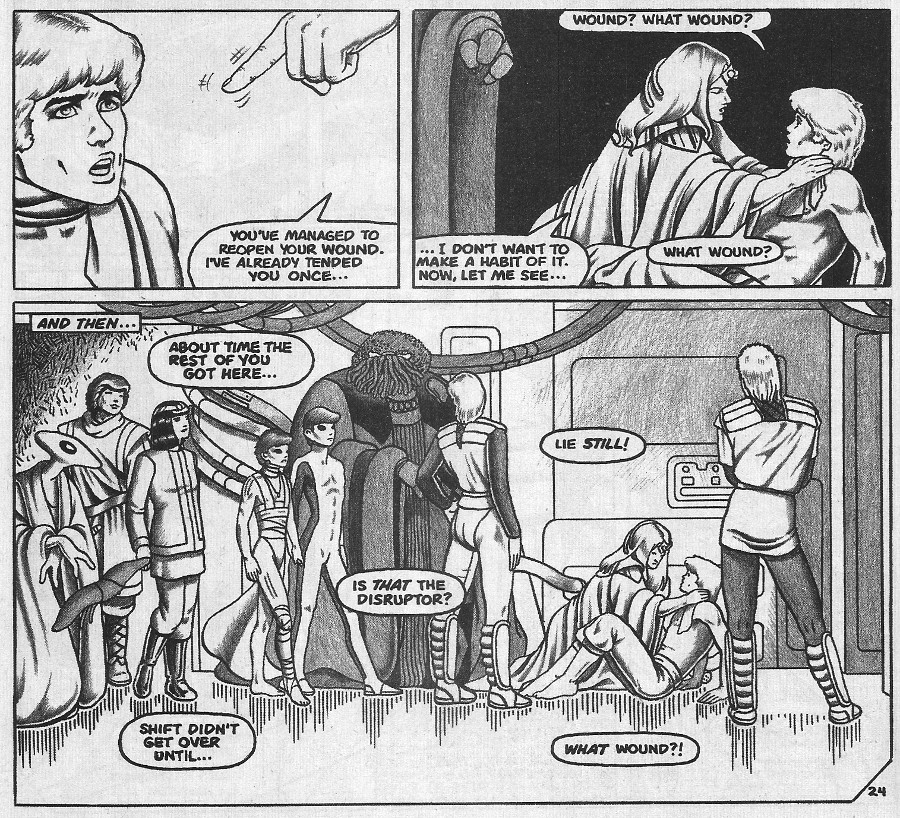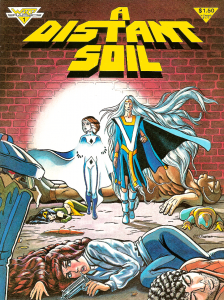 I talk a lot about the explosion of innovation in the comics of the mid-1980’s, because it’s worth talking about. But it’s also worth remembering that the explosion couldn’t have happened if there hadn’t been pioneers preparing the way. For instance, the explosion of self-published and small press black-and-white comics that started with Teenage Mutant Ninja Turtles would not have been possible if it hadn’t been for the success of Dave Sim’s Cerebus the Aardvark and Elfquest by Wendy and Richard Pini, two self-published titles that on the one hand proved there was a market for innovative sophisticated material outside of the clutches of the big two while also proving that black-and-white didn’t have to mean vulgar or pornographic.
I talk a lot about the explosion of innovation in the comics of the mid-1980’s, because it’s worth talking about. But it’s also worth remembering that the explosion couldn’t have happened if there hadn’t been pioneers preparing the way. For instance, the explosion of self-published and small press black-and-white comics that started with Teenage Mutant Ninja Turtles would not have been possible if it hadn’t been for the success of Dave Sim’s Cerebus the Aardvark and Elfquest by Wendy and Richard Pini, two self-published titles that on the one hand proved there was a market for innovative sophisticated material outside of the clutches of the big two while also proving that black-and-white didn’t have to mean vulgar or pornographic.
Both launched in the 70’s and had large fan followings by the early 80’s. But where Sim’s stated goal was to run for at least 300 consecutive issues on Cerebus, Elfquest‘s storyline was scheduled to wrap up after 20 issues, which would leave the Pinis with a publishing company, but nothing to publish. So they began signing deals to publish works by other creators, like Phil Foglio’s adaptation of Robert Asprin’s MythAdventures. But their first new project was a science-fictional adventure that previewed in Elfquest #16, titled A Distant Soil.
It looked like a perfect match on paper. Elfquest had been developed by young artist Wendy Pini as a labor of love for years, and after several disappointing attempts to sell it to the big publishers (and one poor quality issue published by a small press), she and husband Richard decided to publish it themselves, with Wendy doing the art and plotting and Richard doing the scripting and editing. And here was young Colleen Doran, a talented young artist who had also been developing her world and characters for years; with her providing the art and plot, and Richard once again doing the scripting and editing, how could this new story fail to achieve the same magic that Elfquest had?
A Distant Soil centered on Liana and Jason Scott, teen siblings who escaped together from a top-secret institute where their superhuman powers were the subject of study, only to find themselves separated when they are hunted by aliens as well. Jason is kidnapped by the aliens while Liana escapes and falls in with a group of protectors: alien rebels Rieken and D’Mer, human cop Detective Minetti, and teen gang member Brent Donewicz. The art by Doran was beautiful, and since it was being reproduced from the pencils rather than inked, it had a completely unique look that set it apart from every other comic on the market.
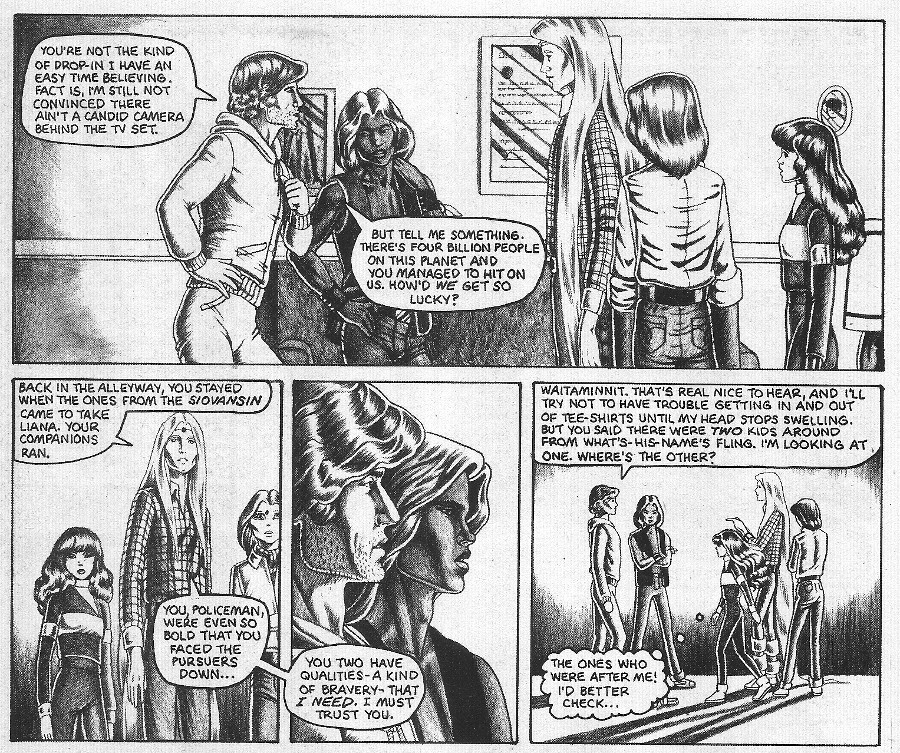
However, there were problems from the start. Pini’s script was extremely wordy, and included some odd choices of emphasis, especially in windy narrative digressions like “Although the Declaration of Independence was signed on July 4th, 1776, the newly born United States was not truly free until over five years later, when Cornwallis’s army was defeated at the Battle of Yorktown. Two centuries later, a decidedly different threat to liberty hangs like a miniature moon in geosynchronous orbit, directly above that old battleground.” And the first issue, instead of setting narrative hooks for later action, instead consists almost entirely of the group sitting around Minetti’s apartment while Rieken tells them backstory.
Meanwhile, Doran’s art had its own problems. The very highly rendered artwork, while often lovely, also often looked stiff, especially in action sequences. And the series encountered an early controversy when they received a letter of complaint that the men were all improbably gorgeous and effeminate. Fangirls immediately jumped to Doran’s defense, saying that not all men needed to be macho brutes. Why, just look at David Bowie.
However, it was a real weakness, in that all of the characters were similarly slender and had similar body language, even when that body language did not fit their characters. Look at tough-guy cop Minetti’s pose above, leaning straight forward from the waist with his butt thrust out and his hand on his hip, while beside him, male horn-dog gang leader Donewicz also has one hand on his hip while rubbing his shoulder with the other hand. He looks like he has a case of the vapors. Both men also have incredibly glossy hair.
Donewicz was also problematic, in that he looked like a dark-skinned Puerto Rican, but had a Polish name, which was hard to reconcile. It was later revealed that Donewicz was actually half-Japanese, with a white sailor for a father and a Japanese mother. Although this was a nicely realistic touch, the art didn’t complement the character, but made him grate on my nerves. Other characters that were revealed to be different from the way the art made them first appear were Rieken’s pre-teen female bodyguard D’Mer, who was actually an adult male of an alien species, and hulking alien brute Omios, who is revealed to be female. And then there were the Ovanan overlords, who are all uniformly tall and slender and androgynous, with long hair that reaches down to the floor. It’s often hard to tell them apart at a distance, and the names don’t help. There are, for instance, Seren and Sere, and Niniri and Ninivir, and Rieken and Rienrie… I can appreciate on an intellectual level the nods to diversity and the idea that first appearances can be wrong, but having to make that mental “oh, wait” adjustment for so many characters made it hard to get involved in the story.
And the characters began to appear in droves. Rieken goes recruiting for people to help him battle the Ovanan heirarchy, while in the alien ship Siovansin, Jason falls in with his own group of rebels. Many of the characters are barely introduced, and many other just appear, like this gang of rebels.
Every time you think they’re done introducing characters, they add to the group, often without even a pause for a name or description, just more bodies to clutter the scenes. And the characters were all over the place: a medical student, an alien shapeshifter, a human magician, a Russian dissident author, and Sir Galahad, crossed over from another dimension. And it was a shame, because it had all seemed so promising at the start.
After 5 issues in the Elfquest format (magazine size, with a thrice yearly publishing frequency), the book shifted to a standard comic book size. Doran took over the scripting, which meant an end to the weird narrative captions, and as her art matured, some of the male characters actually started to look male (Minetti and Galahad especially added some welcome upper body mass). The story, though, lurched forward too quickly, full of nearly anonymous interchangeable characters running back and forth.
Warp upped the frequency to quarterly by dropping the number of primary story pages and adding a back-up feature. And in issue 9, Doran shifted from the lush pencil rendering technique to more standard inks, while it was announced that the book would move to a bimonthly frequency. However, that was the last Warp issue.
And that’s where the story gets strange. Doran left Warp and started the story over, redrawing everything in pen and ink while altering the story. Donning Starblaze, the same company that published the color Elfquest collections, published a new first volume of A Distant Soil, after which they and Doran were sued by Warp for over $4 million (as described in an article in The Comics Journal #115, which I had to search the Fraziersbrain archives for days to find and read). The case was eventually settled, but as far as I can tell, the bad blood remains.
Doran later began to self-publish a new version of the story through her Aria Press imprint (which moved to Image Comics with issue #15), taking a more leisurely approach this time. For instance, the first meeting between Rieken and Soviet dissident Serezha Kirov takes two pages in the Warp version, but expands to six pages in the newer version. The expanded version let us get to know the characters better and explained many of the gaps in storytelling that had occurred in the first version. And there were several changes. Liana in the original was 15, and there was an odd romantic triangle developing between her and older gang leader Brent and much older cop Minetti whom she had a crush on. In the few newer issues I own, Liana looks more like 11-13 years old, and that romantic tension seems to be gone.
Meanwhile, Rieken’s androgynous and mostly silent gay bodyguard D’Mer becomes a major character in the new version, sharing (for instance) a multi-page scene with shapeshifter Bast in which they snipe at each other like a couple of reality-TV drama queens: the Real Housewives of Siovansin.
Just as a final point of comparison, here are two matching scenes, one from issue 9 of the Warp series, and one from issue 25 of the Image comics version.
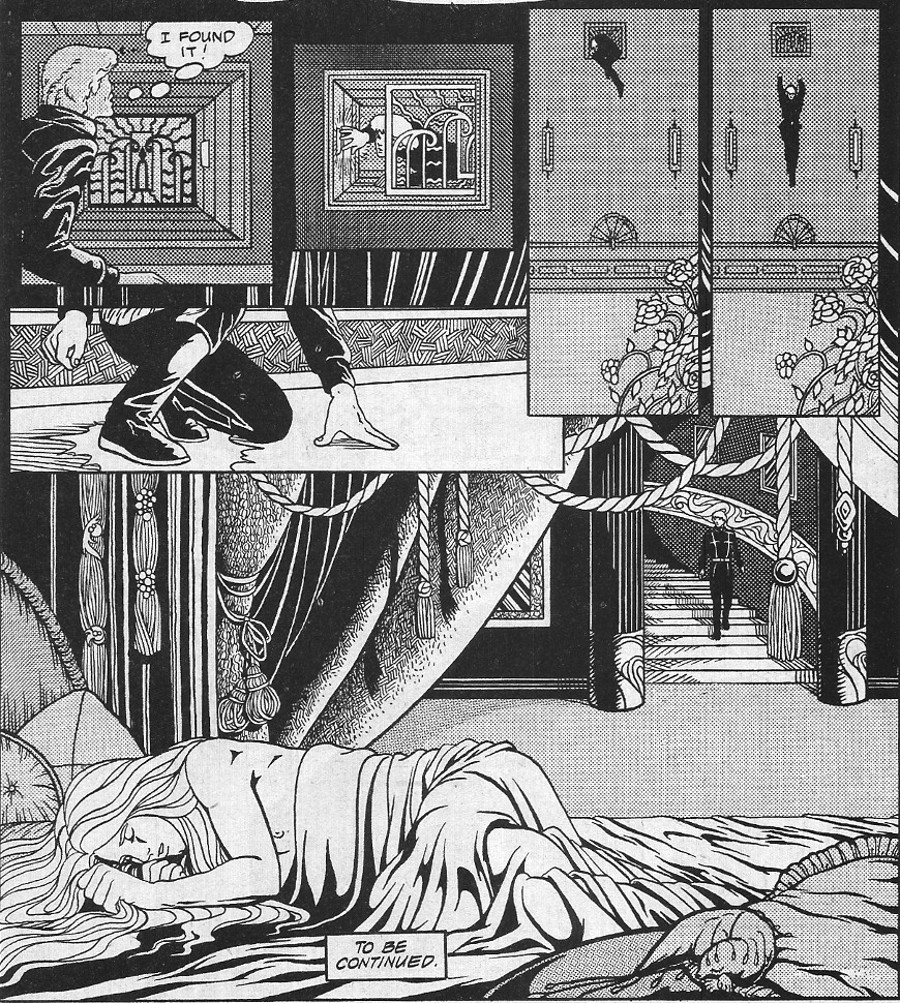
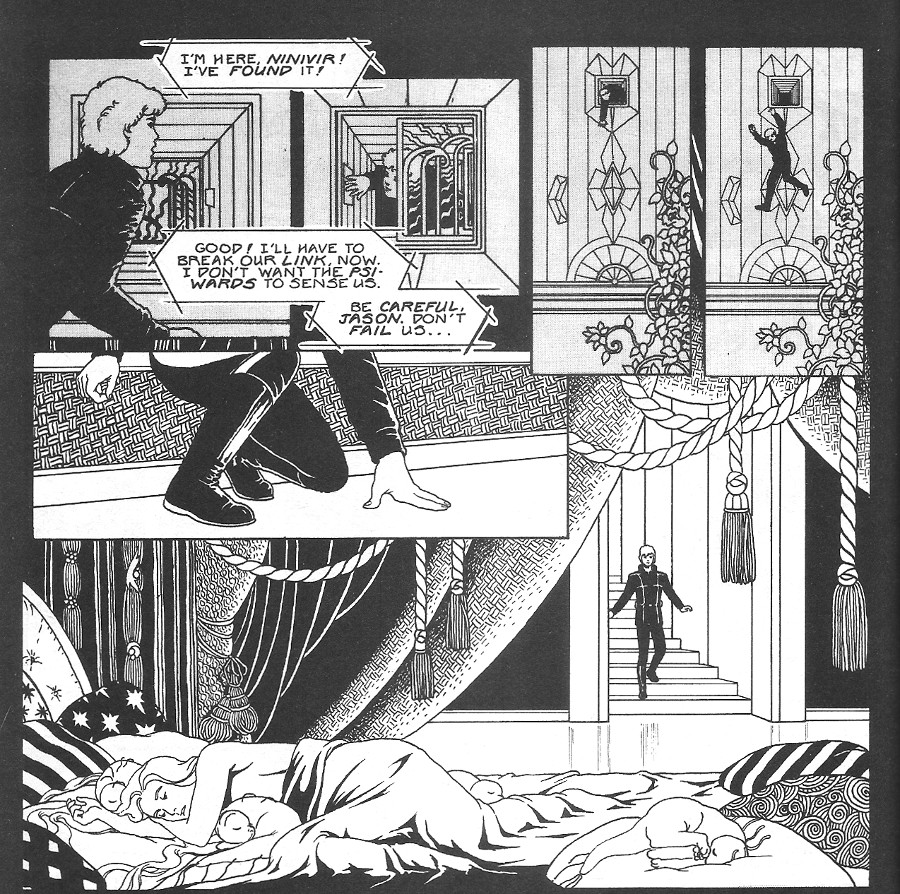
If you’re interested in seeing the story for yourself, Doran has much of it published online at her website, adistantsoil.com.


